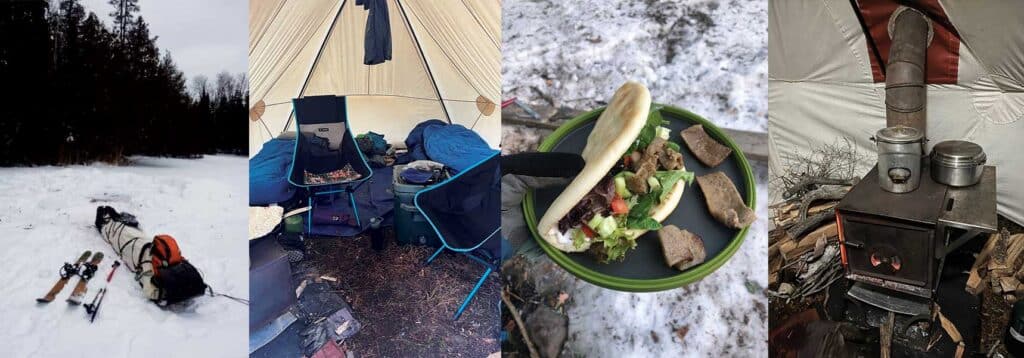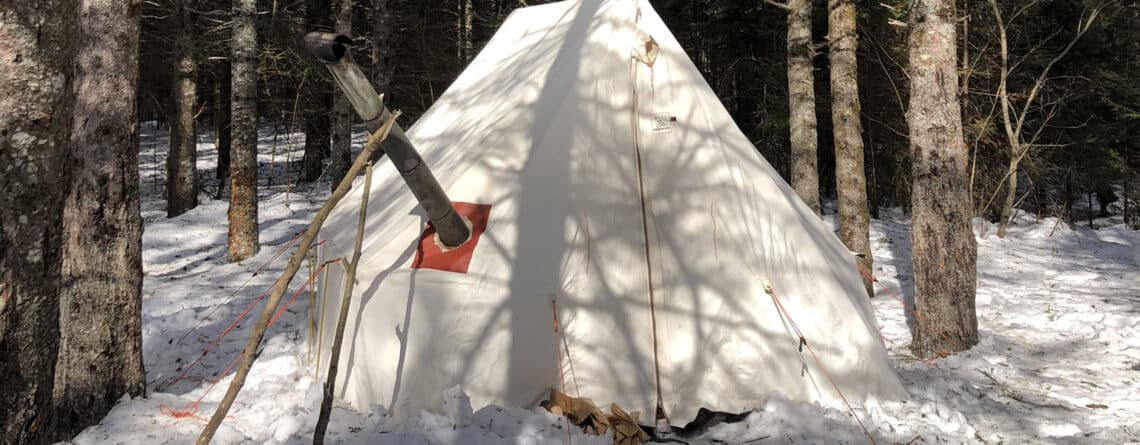Winter Camping Packing List
Winter camping can be a magical experience, offering the unique combination of frosty landscapes outside and cozy warmth inside (if hot tenting).
To make the most of your winter camping adventure in the Boundary Water Canoe Area (BWCA) Wilderness or nearby areas near Lake Superior’s North Shore, proper preparation and a well-thought-out packing list are crucial. Below is a list of essentials we recommend bringing for a comfortable and enjoyable winter camping trip. Plus, at the very end we’ll be sharing some of our favorite tips that we’ve come up with for elevating the experience.
Don’t have what you need? Let us know. We have much of the necessary gear (like hot tents, stoves, toboggans, and camping accessories) available for purchase and/or rent.

Traveling
- Daypack
- Toboggan (with straps)
- Bags/Containers for gear when hauling
- Tarp to wrap gear in
- Snowshoes
- Skis and ski boots for travel (optional)
- Snowshoes for travel (optional)
- Ski or Hiking poles with snow baskets
- Map
- Compass
- GPS
- Handwarmers and footwarmers
- First Aid Kit
- Whistle
- Emergency Shelter
Camp
- Backcountry shovel
- Saw
- Axe
- Ice Auger- (cannot be gas or battery powered if using in the BWCA)
- Matches and lighters
- Water Filter or purification, if needed
- Knife or Multi-tool*
- Duct tape
- Repair kits for pad/mattress and stove*
- Extra cord
- Rope for Clothesline (hang inside tent if hot tenting)
- Fire Gloves
- Headlight
Shelter
- Winter tent (canvas or 4-season)
- Tent-pole repair sleeve
- Wood stove (if using hot tent)
- Snow or tent stakes
- Tarp for sleeping area
Sleeping
- Sleeping bag(s)
- Insulated sleeping pads(s)
- Sleeping bag liner(s)
- Camping Pillow(s)
- Sleeping Cot
- Sit pad(s) or chair(s)
Kitchen
- Insulated Water bottle(s) or water reservoir(s)
- Water filter/purifier or some type of chemical treatment
- Meals
- Snacks
- Hot beverages
- Animal-resistant food container(s)
- Cooking Stove- even if you have a wood stove
- Stove Fuel
- Matches and lighters
- Fire starter (optional)
- Cook set
- Cooking and eating utensils
- Dishes/bowls
- Insulated mugs
- Biodegradable soap
- Pot scrubber/sponge
- Hot pad
- Trash bags
Clothing
- Top base layers
- Top mid-layers (e.g. fleece, down or insulated jackets)
- Top Outer layer (e.g. shell)
- Bottom base layers
- Bottom Mid-layer (e.g. fleece or insulated pants)
- Bottom outer layer (e.g. snow pants or bibs)
- Warm hats
- Neck Warmer or Balaclava
- Gloves or mittens (multiple pairs)
- Socks (wool)
- Winter boots
- Insulated shoes/boots (to use around the tent)
- Gaiters
Toiletries
- Hand sanitizer
- Quick-dry towel
- Toothbrush
- Toothpaste
- Floss
- Toilet paper/wipes
- Menstrual products
- Medications
- Sunglasses
- Sunscreen
- SPF-rated lip balm
Other
- Itineraries left with emergency contact person
- Personal ID
- Notebook and pen or pencil (optional)
- Books (optional)
- Camp games (optional)
Looking for other tips and tricks? Here are a few simple things we’ve learned the years that we like to pass on to others to make their experience better.
- Don’t plan on trying to melt snow as water source. It takes too long. Instead, use an auger to access water if you’re camping by or on a lake.
- Having a metal pot that fits right in your water hole is really helpful. It makes getting water quick and easy.
- Keep a pot of water full on your wood stove so you always have water ready!
- Make your meals ahead of time. Soups, premade tinfoil dinners and burritos are easy to heat up on the wood stove. A fry pad with a thicker bottom is handy for heating up the tinfoil items without burning them.
- Bring a small cooler. Keep your frozen premade meals on the bottom and fresh items
you don’t want to freeze on the top. Plus, the cooler will make a nice table for the tent!
Need help planning your trip? Reach out for recommendations and be sure to view other related resources:


